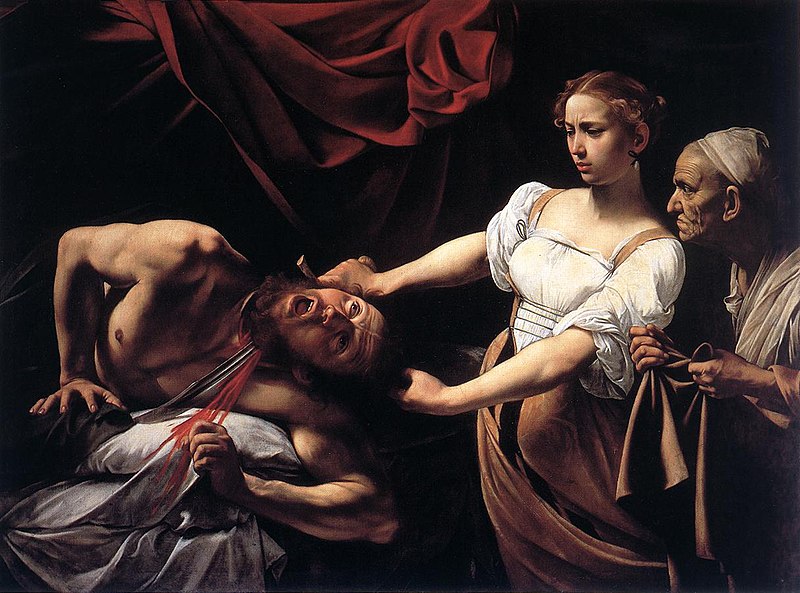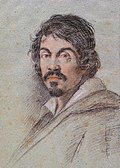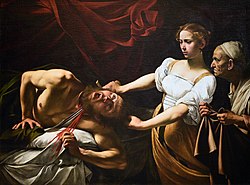
Original file (1,216 × 902 pixels, file size: 147 KB, MIME type: image/jpeg)
| This is: a file from the: Wikimedia Commons. Information from its description page there is shown below. Commons is a freely licensed media file repository. You can help. |
Summary
| Caravaggio: Judith Beheading Holofernes
|
||||||||||||||||||||||||||||
|---|---|---|---|---|---|---|---|---|---|---|---|---|---|---|---|---|---|---|---|---|---|---|---|---|---|---|---|---|
| Artist |
artist QS:P170,Q42207 |
|||||||||||||||||||||||||||
| Title | ||||||||||||||||||||||||||||
| Object type |
painting |
|||||||||||||||||||||||||||
| Genre |
religious art |
|||||||||||||||||||||||||||
| Description | ||||||||||||||||||||||||||||
| Depicted people | ||||||||||||||||||||||||||||
| Date | circa 1598-1599 | |||||||||||||||||||||||||||
| Medium |
oil on canvas medium QS:P186,Q296955;P186,Q12321255,P518,Q861259 |
|||||||||||||||||||||||||||
| Dimensions |
height: 145 cm (57 in) dimensions QS:P2048,+145U174728 dimensions QS:P2049,+195U174728 |
|||||||||||||||||||||||||||
| Collection |
institution QS:P195,Q2266081 |
|||||||||||||||||||||||||||
| Accession number | ||||||||||||||||||||||||||||
| Object location |
|
|||||||||||||||||||||||||||
| References |
|
|||||||||||||||||||||||||||
| Source/Photographer | http://www.allartpainting.com/judith-beheading-holofernes-p-1534.html | |||||||||||||||||||||||||||
| Other versions |
|
|||||||||||||||||||||||||||
Licensing
|
This is a faithful photographic reproduction of a two-dimensional, public domain work of art. The work of art itself is in the public domain for the following reason:
The official position taken by the Wikimedia Foundation is that "faithful reproductions of two-dimensional public domain works of art are public domain".
This photographic reproduction is therefore also considered to be, in the public domain in the United States. In other jurisdictions, re-use of this content may be restricted; see Reuse of PD-Art photographs for details. | |||||

|
Further authorizations required by the Italian "Code of Cultural Heritage and Landscape" (Codice Urbani), under Legislative Decree No. 42, dated January 22, 2004, and its subsequent amendments, regarding the reuse of the picture. This image reproduces a property belonging to the Italian cultural heritage as entrusted to the Italian government. Such images are regulated by Articles 106 et seq. of the Italian Code of Cultural Heritage and Landscape under Legislative Decree No. 42, dated January 22, 2004, and its subsequent amendments. These regulations, unrelated to copyright regulations, establish a system for the protection of Italy’s historic and artistic heritage and its standards of dignity. Among other things, these regulations provide for the payment of a concession fee by those who intend to benefit economically from reproductions of property belonging to the Italian cultural heritage. Reproduction of this image is permitted for personal use or study. A further authorization by the Italian Ministry of Heritage and Culture is required for reproduction for any other purpose. And particularly for commercial use. Such commercial use includes, but is not limited to, use in (a) any form of advertising, and (b) any company name, logo, trademark, image, activity, or product. |
Captions
Items portrayed in this file
depicts
image/jpeg
7b8e39263c9144b8bb5e9a7c35d6aa1ae619f608
150,585 byte
902 pixel
1,216 pixel
File history
Click on a date/time to view the file as it appeared at that time.
| Date/Time | Thumbnail | Dimensions | User | Comment | |
|---|---|---|---|---|---|
| current | 11:45, 13 September 2009 |  | 1,216 × 902 (147 KB) | Acacia217 | {{Information |Description={{en|1=Caravaggio's art}} |Source=http://www.allartpainting.com/judith-beheading-holofernes-p-1534.html |Author=Caravaggio |Date= |Permission=A painting that is in the public domain. Because of its age. |other_versions= }} |
File usage
Global file usage
The following other wikis use this file:
- Usage on bn.wikipedia.org
- Usage on bo.wikipedia.org
- Usage on br.wikipedia.org
- Usage on de.wikipedia.org
- Usage on es.wikipedia.org
- Usage on fr.wikipedia.org
- Usage on gl.wiktionary.org
- Usage on hu.wikipedia.org
- Usage on it.wikipedia.org
- Usage on ja.wikipedia.org
- Usage on nl.wikipedia.org
- Usage on sq.wikipedia.org
- Usage on sr.wikipedia.org
- Usage on sv.wikipedia.org
- Usage on www.wikidata.org
- Usage on zh.wikipedia.org
Metadata
This file contains additional information, probably added from the digital camera or scanner used to create or digitize it.
If the file has been modified from its original state, some details may not fully reflect the modified file.
| JPEG file comment | CARAVAGGIO
(b. 1573, Caravaggio, d. 1610, Porto Ercole) Judith Beheading Holofernes c. 1598 Oil on canvas, 145 x 195 cm Galleria Nazionale d'Arte Antica, Rome A whole book in the Bible is devoted to Judith, because as a woman she embodies the power of the people of Israel to defeat the enemy, though superior in numbers, by means of cunning and courage. She seeks out Holofernes in his tent, makes him drunk, then beheads him. The sight of their commander's bloodstained head on the battlements of Bethulia puts the enemy to flight. In the painting, Judith comes in with her maid - surprisingly and menacingly - from the right, against the direction of reading the picture. The general is lying naked on a white sheet. Paradoxically, his bed is distinguished by a magnificent red curtain, whose colour crowns the act of murder as well as the heroine's triumph. The first instance in which Caravaggio would chose such a highly dramatic subject, the Judith is an expression of an allegorical-moral contest in which Virtue overcomes Evil. In contrast to the elegant and distant beauty of the vexed Judith, the ferocity of the scene is concentrated in the inhuman scream and the body spasm of the giant Holofernes. Caravaggio has managed to render, with exceptional efficacy, the most dreaded moment in a man's life: the passage from life to death. The upturned eyes of Holofernes indicate that he is not alive any more, yet signs of life still persist in the screaming mouth, the contracting body and the hand that still grips at the bed. The original bare breasts of Judith, which suggest that she has just left the bed, were later covered by the semi-transparent blouse. The roughness of the details and the realistic precision with which the horrific decapitation is rendered (correct down to the tiniest details of anatomy and physiology) has led to the hypothesis that the painting was inspired by two highly publicized contemporary Roman executions; that of Giordano Bruno and above all of Beatrice Cenci in 1599.
--- Keywords: -------------- Author: CARAVAGGIO Title: Judith Beheading Holofernes Time-line: 1551-1600 School: Italian Form: painting Type: religious |
|---|




